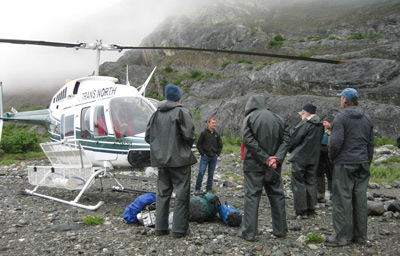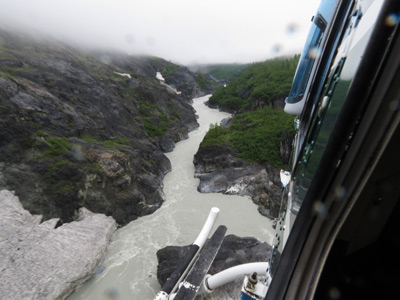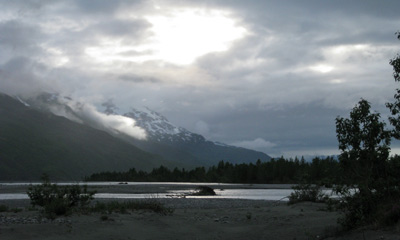Alsek River 2014
Day 7, Monday, June 30
We awoke to more rain, and it just sent Susie over the edge. A real meltdown. Sarah noticed, as did others. Sarah just shook her head. Susie tends to keep her emotions fairly close to the skin, and does not hesitate to express how she feels. How is THAT for being nice and neutral? Anyway, we got started hauling gear over to the standby area, and Joe noticed Susie’s demeanor, and gave her a big hug. That seemed to help quite a bit.
 We had finished breakfast and
were pushing to get things packed up and ready for the scheduled 9 am
arrival of the helicopter. We had just taken down the mega-tarp when
we heard the whop-whop-whop of the helicopter blades. I looked at my
watch and it was 8:20 am. Hey, early is good. We had already received
our ‘copter safety lecture from Sam, which was pretty straightforward.
Essentially, it boiled down to a) generally stay away from the
helicopter unless told to move closer by the pilot, b) always go in
the direction that the pilot tells you and c) never ever go near the
tail rotor of the helicopter. That last one was burned in my mind,
remember how the surgeon on the TV show “ER” lost his arm: it was
chopped off by a tail rotor of a medivac helicopter. It still makes me
shake to think about it.
We had finished breakfast and
were pushing to get things packed up and ready for the scheduled 9 am
arrival of the helicopter. We had just taken down the mega-tarp when
we heard the whop-whop-whop of the helicopter blades. I looked at my
watch and it was 8:20 am. Hey, early is good. We had already received
our ‘copter safety lecture from Sam, which was pretty straightforward.
Essentially, it boiled down to a) generally stay away from the
helicopter unless told to move closer by the pilot, b) always go in
the direction that the pilot tells you and c) never ever go near the
tail rotor of the helicopter. That last one was burned in my mind,
remember how the surgeon on the TV show “ER” lost his arm: it was
chopped off by a tail rotor of a medivac helicopter. It still makes me
shake to think about it.
I think Susie and I were blown away by how efficient the process was. First, the three large cargo nets that the pilot had flown in were spread out on the ground. We all helped to move first the deflated rafts with frames attached on to the center of the spread out net. Then, all the other gear was stacked on top of the frame, using the aluminum tables as a shelf. The net was then gathered up and the corners secured. Next the pilot gathered us around the helicopter (engine off) and explained how the whole process would work, where we could sit inside, and what gear we were permitted to have in our possession on the copter (cameras only) and what gear would go in the cargo section of the plane (our day packs). Finally, he told us how he would handle things and what order the passenger vs the cargo flights would be done. He would have to make a total of six trips for the portage: three passenger trips and three cargo flights. But they would not happen in that order.
So, the first thing that happened was that the clients were divided into three groups. One guide would go with each group. I wanted to take movies of the helicopter picking up and flying off with the cargo loads, so I agreed to be in the last flight. So the pilot flew the first two groups of passengers down the canyon to the landing site, which, based on my examination of satellite photos and the surrounding terrain, looks to be about 9 river miles from our camp. The two groups of people were brought down so that as soon as the cargo loads were dropped, the crew could start re-inflating and loading the rafts. I think I timed a round trip to be something like 20 minutes.
 The cargo pick up was really
neat: The helicopter would come in, bringing a long (maybe 100 feet)
cable with an attachment hook at the end. It would hover so that the
cable was next to, but not above the gear net filled with gear. Sam
would hook the gear net to the cable device, the pilot would lift it
slightly off the ground as Sam walked away (he was wearing ear
protection) and then fly away. The entire process (fly into position,
hook the net to the cable, test the weight of the load, and fly off)
took less than 60 seconds.
The cargo pick up was really
neat: The helicopter would come in, bringing a long (maybe 100 feet)
cable with an attachment hook at the end. It would hover so that the
cable was next to, but not above the gear net filled with gear. Sam
would hook the gear net to the cable device, the pilot would lift it
slightly off the ground as Sam walked away (he was wearing ear
protection) and then fly away. The entire process (fly into position,
hook the net to the cable, test the weight of the load, and fly off)
took less than 60 seconds.
Finally, after two loads of people and three loads of gear, the pilot returned for us. No screwing around. Get your day packs in the rear cargo compartment and get in the seats. I was able to fly in the co-pilot’s seat, so was able to shoot video out the front window, which, of course, is a giant glass bubble. That was the good news. The bad news was that it was still drizzling a bit, so the views were not as good as they might otherwise have been. The ride in the helicopter was right down Turnback Canyon, often at or slightly below the elevation of the rim. I felt like the helicopter was flying like a skier would run a Giant Slalom race, because a lot of the time, we were tilted significantly. Especially flying what seemed to be directly at a canyon wall. Susie, riding in the rear seats, along with Sam, and Sarah, had never flown in a helicopter before. And the only copter I had been in was a passenger shuttle helicopter between JFK airport and Newark Airport. So this was a completely different experience.
The flight took just a few seconds longer than seven minutes, according to the video I shot, from takeoff to touchdown. The first part of the route the face of the Tweedsmuir Glacier is visible, then one flies into the canyon. The flight gives you a real sense as to why the canyon is un-runnable but anyone other than super experts in kayaks: the river, that has been from several hundred yards up to a half mile or more wide in places up until now, is squeezed down so as to pass through a notch in the canyon that is only 35 feet wide at one spot. Nearly time the copter tilted so I could look down at the water, there was some set of horrible (for a party in a raft) rapids right below me.
 After we cleared the end of the canyon, you still have to get over the
SE corner of the glacier, where it is hard to tell what is real earth
and what is just dirt and rock covered ice, alternating with pools of
gray water. Finally, I could pick out our landing zone where a creek
flows out of a valley on river left. All the rest of the folks were
far away from the LZ, so the pilot could come in efficiently and
disgorge his load of humans. We have posted snipets of the flight here: (the entire video
is too big to upload)
After we cleared the end of the canyon, you still have to get over the
SE corner of the glacier, where it is hard to tell what is real earth
and what is just dirt and rock covered ice, alternating with pools of
gray water. Finally, I could pick out our landing zone where a creek
flows out of a valley on river left. All the rest of the folks were
far away from the LZ, so the pilot could come in efficiently and
disgorge his load of humans. We have posted snipets of the flight here: (the entire video
is too big to upload)
We all got out of the helicopter and walked out straight ahead, as we had been told. Sam talked briefly with the pilot, who packed the cargo nets in the helicopter, fired up the engine, and took off. He flew over us as sort of a final wave goodbye, and was gone, headed back up river. The entire process had taken something like 2 hours and 20 minutes. Amazing!
People have since asked me if, in mid-trip, the helicopter had intruded into my “wilderness experience” of the trip. I guess the answer is sort of a “Yes and No.” Clearly to have some large machine land near you, and have you ride in it, could easily be considered an intrusion. But that said, the area in which we were traveling specifically was no longer designated “big W” Wilderness, as it would be once we entered the United States. But more importantly, the reality of the trip is such that portaging all the gear across a glacier, one that is as heavily crevassed as most of the ones we have seen, is just not practical or safe. Yes, I am sure it can be done. I am also sure it would take several days. And hauling the deflated rafts over this type of terrain would not be something one person could do with a sled. But most importantly is the safety issue. As someone who has taken a snow and ice climbing/glacier travel class with Rainier Mountaineering, it is my considered opinion that traveling on the glaciers, without a rope team, crampons and climbing harnesses, with this much gear, at this time of year, would be akin to a suicide mission. Now, you might think: “OK, we can portage in early spring, when there is lots of snow on the glacier, and travel is easier.” Yeah, you can do that. But as it would turn out (read on a few days), you need to be doing this in the maximum snow melt time of the year, to insure that river water levels are near their maximum, so you don’t have to do another multi-day portage at the end of the trip. So I guess, to my mind, you either accept the “intrusion” of the helicopter portage (and of course, the cost, which is several thousand dollars per group) and run the Alsek river, or, you say: hey, I don’t want that part of the experience, and run the Tatshenshini River. Such are the choices in life.
Next task was continuing to repack the boats and get lunch on the table, so to speak. We had not done much this morning, but hey, we were happy to eat. I had, by now, figured out that when given the chance on this trip, you eat. Because dinner might be at 6 pm or 9 pm. Weather and the river dictate the schedule, and us humans are it its mercy. Lunch was served at 11:30 and we were on the river shortly after noon time. It was but a few minutes after we launched that the rain re-started. Low clouds obscured many of the surrounding mountains. Susie and I were in Thirsty’s raft, with Thelonious and his dad, DB. We made a stop for some wood, and then continued on. Sam had decided he wanted to pull into what he called the “Island Camp.” Actually, looking at it on satellite photos, it sorta looks like an island, but there were a fair number of braids behind it, and Susie would mention later that based on some of her explorations, she thought it was really attached to the “mainland” on river left. At any rate, we pulled into camp (8V, 337922 E, 6604780 N) at a very luxurious 3:15 pm. Susie commented that the guides looked really whipped. Well, I was not sure why. I am certain they had been getting at least 3.5 hours of sleep every night, and dealing with zero gear, and had chefs flown in to cook each meal, and were dealing with only the very best of all possible client groups.
 I asked Sam if he wanted to
erect the giant tarp right away, but he suggested that since there
seemed to be a slight break in the rain, we should erect the tents
first and then, when he thought it would be appropriate, to conduct
what he called “Tarpology.” Hey, that worked for us. In my search for
a spot to take a bio-break, I had found an abandoned braid of the
river, where the sediment had settled out mostly, and the water was a
beautiful blue. Susie decided she would accompany me on my clean up
mission, albeit just for a very brief wash. Mine was not much longer,
as it started sprinkling again. I looked around at the low clouds and
wondered if they would lift any time soon. We could see the face of
the Vern Ritchie glacier, but not very far beyond its face. We KNEW
there were big mountains on either side of the river, but alas, they
were obscured.
I asked Sam if he wanted to
erect the giant tarp right away, but he suggested that since there
seemed to be a slight break in the rain, we should erect the tents
first and then, when he thought it would be appropriate, to conduct
what he called “Tarpology.” Hey, that worked for us. In my search for
a spot to take a bio-break, I had found an abandoned braid of the
river, where the sediment had settled out mostly, and the water was a
beautiful blue. Susie decided she would accompany me on my clean up
mission, albeit just for a very brief wash. Mine was not much longer,
as it started sprinkling again. I looked around at the low clouds and
wondered if they would lift any time soon. We could see the face of
the Vern Ritchie glacier, but not very far beyond its face. We KNEW
there were big mountains on either side of the river, but alas, they
were obscured.
Dinner was served about 7 pm and it was the most amazing one of the trip so far. Baked salmon filets, this superb pasta with both classic and sun-dried tomato pesto on it, a wonderful tossed salad, and chocolate cake, baked by Joe, the resident Dutch Oven expert. Oh man, it was all really good, and I confessed that I ate too much. About 8:15 pm, we all noticed what our friend Carolyn would call a “sucker hole,” based on the concept that it sucks you into thinking the weather would clear off. We all ran down to an upstream spot on the beach, and photographed it. Hey, it was not raining, which was a very good thing. I think many of us were in bed by 9 pm, however, Susie and I stayed up, in our tents reading and writing, until about 10 pm.
Additional Photos and videos can be found here: The Alsek Days 5 - 8 album on our SmugMug Photo Album Site
You might enjoy reading a different perspective on this same trip: Sarah Boomer's Report on the Thermophile.org website
© Roger A. Jenkins & Suzanne A. McDonald, 2014, 2016
